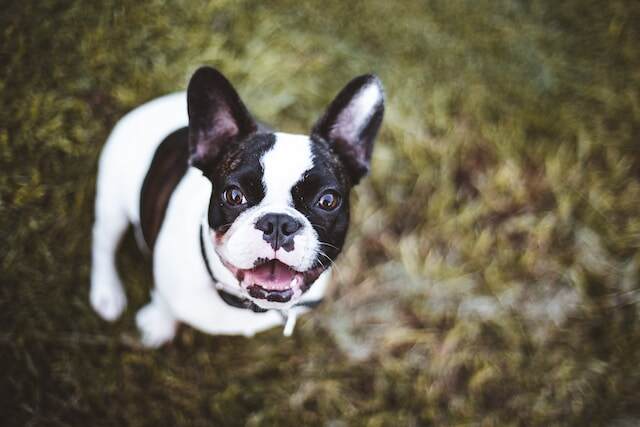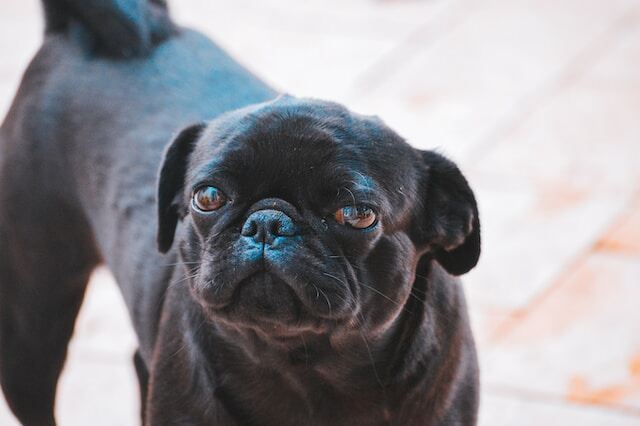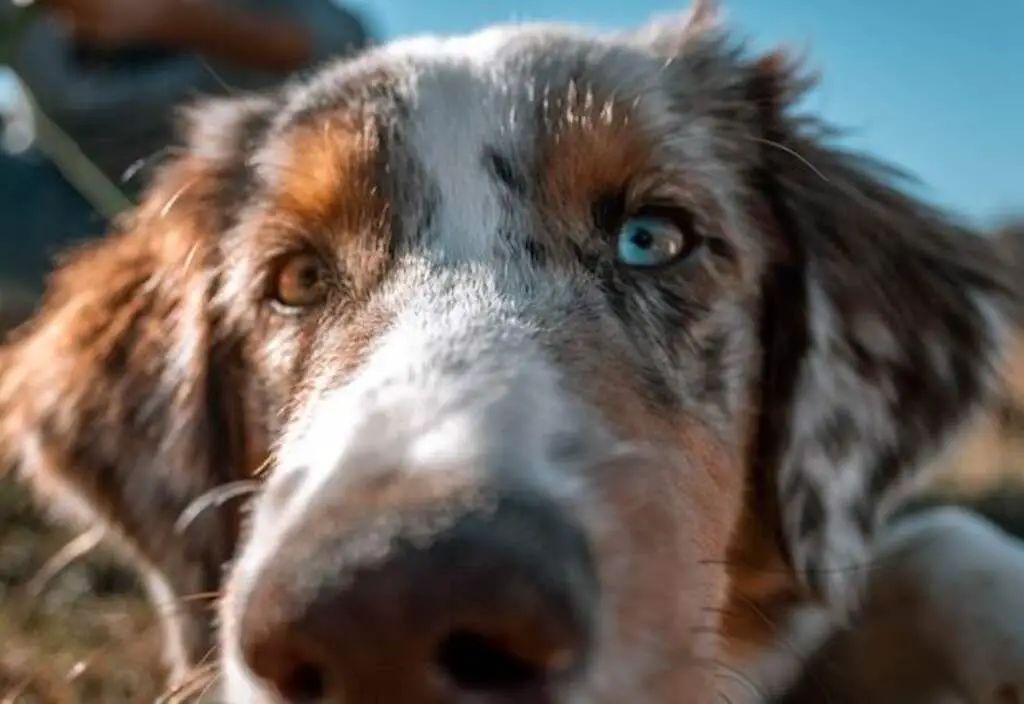Have you ever wondered why a dog sniffs you when you first meet? Sniffing is a natural behavior in dogs and plays a critical role in their communication. It’s essential to understand why dogs sniff and what it might indicate.
In this section, we will delve into the significance of a dog sniffing behavior. We will explore the reasons behind why dogs sniff humans and how it plays a role in their communication. Let’s take a closer look at what it means when a dog sniffs you.
Key Takeaways
- Sniffing is a natural behavior in dogs and serves as a vital means of communication.
- When a dog sniffs you, it gathers essential information about your scent, emotions, and health.
- Sniffing is a way for dogs to explore their environment and establish connections with humans and other animals.
- Avoid pulling away when a dog sniffs you, as it’s a friendly gesture and an attempt to get to know you better.
- Allow your dog to sniff during walks, as it enriches their sensory experience and enhances their overall well-being.

What Does it Mean When a Dog Sniffs You
When a dog sniffs you, it’s a natural behavior serving as a form of communication. Sniffing gathers vital information about your scent, emotions, and health. It’s a way for dogs to explore their environment and establish connections with humans and other animals.
Avoid pulling away, as it’s a friendly gesture to get to know you better. During walks, allow dogs to sniff, enriching their sensory experience and enhancing their well-being. Understanding the significance of sniffing helps foster a stronger bond between dogs and their owners.
Canine Communication through Sniffing
Dogs have a unique method of communication, and sniffing is a significant part of this. Dogs’ sense of smell is highly developed, with up to 300 million olfactory receptors in their noses, compared to humans, who have around 6 million.
The part of the brain dedicated to processing smells is also proportionally larger in dogs than in humans. This means that dogs rely heavily on their sense of smell to understand the world around them.
When a dog sniffs something or someone, they are essentially getting a wealth of information. It’s not just about identifying smells; dogs can interpret the chemical messages that make up a scent, which can provide valuable insights into the object or person they are sniffing.
During sniffing, dogs also use body language to communicate their intentions and emotions. For example, a relaxed and open posture during sniffing can indicate a friendly intent, while stiff body language might indicate that the dog is feeling anxious or uncomfortable.
Canine Communication through Sniffing
| Type of Sniff | Meaning |
|---|---|
| Investigative Sniff | A dog is gathering information about an object or person, trying to learn more. |
| Friendly Sniff | A dog is greeting another dog or person in a calm and relaxed way, showing no signs of aggression. |
| Anxious Sniff | A dog is exhibiting tense body language while sniffing, often accompanied by nervous behaviors like pacing or whining. |
By interpreting dogs’ olfactory communication and body language during sniffing, we can gain a better understanding of their intentions and emotions. This can ultimately lead to better communication and a stronger bond between humans and their furry friends.
The Science Behind Dog Sniffing
As humans, we rely heavily on our vision to navigate the world. However, for dogs, their sense of smell is their primary tool for interpreting and understanding their environment. A dog’s sense of smell is estimated to be 10,000 to 100,000 times more powerful than that of a human, due to their highly developed olfactory system.
Dogs have up to 300 million olfactory receptors in their noses, compared to our six million, and their brains are specialized for processing scent information. In fact, the portion of a dog’s brain devoted to analyzing smells is proportionally 40 times greater than that of a human’s.
When dogs sniff, they are able to detect a wide range of information, including the presence of familiar scents, the emotional state of humans and other animals, and even changes in our health. For example, dogs can be trained to detect changes in blood sugar levels, which can be an early indication of diabetes.
During sniffing, dogs also gather information about the time and direction of a scent, allowing them to track and locate the source of the smell. They also use different types of sniffs to gather different types of information. For example, a quick investigative sniff is used to detect new scents, while a longer, more focused sniff is used to gather more detailed information about a scent.

Why Do Dogs Sniff Humans?
Have you ever wondered why dogs love to sniff us so much? There are several reasons behind this behavior, and it’s important to understand them to better communicate with our furry friends.
One reason dogs sniff humans is to familiarize themselves with our scent. Dogs have an incredible sense of smell, and they use it to identify different people and objects. By sniffing us, they are gathering information about our identity and becoming more familiar with our scent. This can also help them feel more comfortable around us.
Another reason dogs sniff humans is to gather information about our emotions and health. Dogs can detect subtle changes in our body chemistry that may indicate stress or illness. By sniffing us, they can pick up on these changes and use them to assess our emotional and physical state.
Finally, dogs also sniff humans to establish social connections. When dogs meet each other, they often sniff each other’s noses and genital areas to exchange information and establish social hierarchies. Similarly, when dogs sniff humans, they are seeking to establish a social connection and build a relationship with us.
Overall, dogs sniff humans for a variety of reasons, and it’s important to allow them to engage in this behavior during social interactions. By understanding why dogs sniff us, we can better communicate with our furry friends and strengthen our bond.
Sniffing and Socialization
When dogs meet each other, they often engage in a ritual of mutual sniffing that can last several seconds. This behavior is not only a means of gathering information but also a way of building social connections. For dogs, sniffing is the equivalent of shaking hands or exchanging business cards.
During a sniffing interaction, dogs gather valuable information about each other, such as gender, age, reproductive status, and social rank. They also learn about each other’s emotional state, health status, and recent experiences. By sniffing each other’s anal area, dogs can obtain a lot of information about the other dog’s identity and history.
Humans can also benefit from allowing dogs to engage in sniffing behavior during social interactions. Dogs use their sense of smell to gather information about humans, including their mood, health status, and recent activities. Allowing dogs to sniff us can build trust and strengthen our bond with them.
However, it’s important to remember that not all dogs may be comfortable with close-up sniffing from unfamiliar humans. Some dogs may be anxious or fearful and may perceive a human approaching too closely as a threat. For this reason, it’s important to approach dogs carefully and ask the owner’s permission before petting or interacting with them.
One way to engage in interactive sniffing games with your dog is to hide treats or objects around your house or yard and encourage your dog to find them by sniffing. This can be a fun and stimulating activity for dogs that can help build their confidence and reinforce their natural sniffing instincts.
Interpreting Dog Sniffs: What to Look For
Understanding your dog’s sniffing behavior can provide you with valuable insights into their intentions and emotions. Here are some things to look for when interpreting a dog’s sniffs:
- Investigative sniffs: When a dog is investigating a new scent, they will take quick and shallow sniffs. They might also move their head from side to side to get a better idea of where the scent is coming from.
- Friendly sniffs: When a dog is greeting someone or something they know, they will take longer and deeper sniffs. They might also wag their tail or lick the person or animal they are sniffing.
- Anxious sniffs: When a dog is feeling anxious or stressed, they may sniff rapidly and excessively. They might also exhibit other signs of anxiety, such as panting or pacing.
It’s important to take note of the context in which your dog is sniffing, as this can also provide clues to their intentions and emotions. For example, if your dog is sniffing a person who is displaying nervous body language, it’s possible that your dog is picking up on their anxiety and reacting accordingly.
Tip: Paying attention to your dog’s body language alongside their sniffing behavior can give you a more complete understanding of how they are feeling and what they are trying to communicate.
Remember, every dog is unique, and their sniffing behavior can vary depending on their personality, past experiences, and current environment. By observing your dog’s sniffs and taking note of their body language, you can start to build a better understanding of their individual communication style.

Building a Stronger Bond Through Sniffing
Sniffing can be a wonderful bonding experience between you and your dog. It’s a way for you to communicate and connect on a deeper level. Here are some tips for engaging in interactive sniffing games and activities with your furry friend:
- Hide and Seek: Hide treats or toys throughout your home or yard and encourage your dog to use their nose to find them.
- Scent Work: Enroll your dog in a scent work class where they can learn to identify and locate specific scents.
- Sniff Walks: Take your dog on walks where they can spend time sniffing and exploring their surroundings.
By engaging in these activities, you can learn to better understand your dog’s body language and sniffing cues. You may even be able to identify certain scents that your dog is particularly drawn to, allowing you to incorporate them into future bonding activities.
It’s important to remember that sniffing serves a vital role in a dog’s communication and should not be discouraged or punished. Instead, use it as an opportunity to strengthen your bond with your furry friend.
Common Misconceptions About Dog Sniffing
There are many misconceptions surrounding dog sniffing behavior that can lead to misunderstandings about our furry friends. Here, we will address and debunk some common myths about dog sniffs.
Dogs only sniff to identify smells
While it’s true that dogs use their sense of smell to identify scents, sniffing is also a vital part of their communication. Dogs use different types of sniffs to convey different messages, such as investigative sniffs to gather information or friendly sniffs to establish social connections.
Dogs only sniff to find food or other rewards
While dogs certainly use their sense of smell to locate food and other rewards, they also use sniffing as a way to gather information and communicate. Sniffing can provide dogs with valuable insights into their environment, other animals, and humans.
All dogs sniff in the same way
Just like humans have different personalities and communication styles, dogs also have unique ways of sniffing and communicating through scent. It’s essential to observe and understand your dog’s sniffs and body language to better interpret their intentions and emotions.
All dog sniffing behaviors are instinctual
While some dogs may have a stronger instinct for sniffing than others, it’s important to recognize that sniffing behaviors can also be learned and trained. Dogs can be trained to detect specific scents, such as drugs or explosives, and can also learn to use sniffing as part of interactive games with their owners.
Dogs only sniff when they are curious or investigating
Dogs use sniffing for a variety of reasons, including gathering information, establishing social connections, and detecting changes in their environment. It’s common for dogs to sniff their owners to detect changes in their emotions or overall health, for example.

FAQ: What Does it Mean When a Dog Sniffs You?
There are several questions that pop up when we talk about dog sniffing behavior. Here we have compiled some commonly asked questions to help you understand better:
Why does my dog sniff me all the time?
Dogs use their sense of smell to gather information about their surroundings and establish social connections. Sniffing is a way for them to explore their environment, identify familiar scents, and understand our emotions and health. Your dog sniffs you to gain information about you and bond with you.
Why do dogs sniff each other’s rear ends?
Dogs sniff each other’s rear ends to gather information about the other dog’s sex, health, and general condition. It’s a way for them to identify other dogs and establish social hierarchies. Dogs have scent glands in their anus, which leave a unique odor that can tell other dogs important details about them.
Is it safe for my dog to sniff strangers?
Allowing your dog to sniff strangers can be an excellent way to socialize them. However, you should be cautious when introducing them to new people, especially if your dog is anxious or aggressive. Always supervise interactions, and never force your dog to interact with someone they are uncomfortable with.
Can I encourage my dog to sniff less?
While sniffing is a natural behavior for dogs, excessive sniffing could indicate anxiety or stress. You can encourage your dog to sniff less by providing them with plenty of exercise and mental stimulation. Training your dog to focus on you through games and activities can also help reduce their sniffing behavior.
What should I do if my dog’s sniffing behavior changes suddenly?
If you notice a sudden change in your dog’s sniffing behavior, it could indicate an underlying health issue or anxiety. It’s best to consult with your veterinarian to rule out any medical conditions and work with a professional trainer or behaviorist to address any behavioral issues.
Can sniffing be used for training purposes?
Sniffing can be an excellent tool for training and mental stimulation. You can train your dog to find hidden treats or toys through scent games, which can enhance their problem-solving skills and keep them mentally sharp. Just make sure to supervise these activities to ensure your dog doesn’t ingest anything harmful.
Is it safe for my dog to sniff other dogs’ waste?
While it is a natural behavior for dogs to sniff other dogs’ waste, it can be dangerous since it can cause the spread of illnesses or parasites. It’s best to discourage the behavior and train your dog to focus on other activities during walks or outdoor playtime.
What can I do to better understand my dog’s sniffing behavior?
Observing your dog’s body language and vocalizations during sniffing can provide valuable insights into their intentions and emotions. You can also interact with them through games and activities that involve sniffing. Paying attention to their preferences and reactions while engaging in these activities can help you better understand your dog’s unique personality and communication style.


